If you decide to kennel train an adult dog (that’s never before been trained to stay in a kennel or crate), you will certainly have to live through your own series of mini-crises like we did. Only yours will be based on your dog’s own personality and overall adaptability.
Every situation is different.
Here’s how we survived the whole crate-training ordeal with Destin (pictured here on the right). Our other dog, Tenor (on left), was crate-trained from Day One, so it was never an issue for him. Tenor got used to his crate after a couple of days.
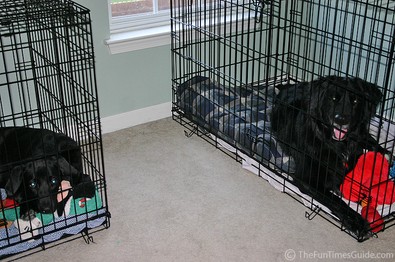
But we stuck with it, and it eventually worked out.
All it took was a couple weeks of us and our dog being a little more “on edge” than usual. But we all got through it in the end, and we are so glad that both of our dogs are now kennel trained!
Our advice, based on what worked for us:
#1. Stick to your goal. And don’t be intimidated by your dog.
Remember, YOU are the Alpha dog, the minute you give in and let him call the shots, then you’ve lost the respect of your dog and it will be an uphill battle to train him from that point forward. As long as your dog sees you as the one in control at all times, then the task of teaching a new behavior (such as staying in a kennel for hours at a time) becomes easier over time, rather than harder.
Trust me on this one.
#2. Resist the urge to change things inside the kennel.
Every time I cleaned up the inside of Destin’s crate and put in a new sheet, dog pillow, or other “comfort” items, he just shredded them again. However, the first time I left all of the old shredded bedding inside his kennel (after closely inspecting and removing any small or dangerous parts), he stopped shredding stuff!
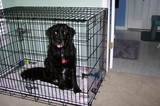 Perhaps because there was very little left that he could shred. Perhaps it was because he finally felt in control and he was comfortable with his surroundings — just as he’d left them. Whatever the reason, he never shredded up items or chewed on things he wasn’t supposed to chew on anymore.
Perhaps because there was very little left that he could shred. Perhaps it was because he finally felt in control and he was comfortable with his surroundings — just as he’d left them. Whatever the reason, he never shredded up items or chewed on things he wasn’t supposed to chew on anymore.
So, while you may be inclined to keep making it a “neat and clean” environment inside the kennel for your dog, this may be one time when a little messiness doesn’t hurt… in fact it may HELP!
#3. Slowly increase the amount of time you leave your dog in the kennel.
As we learned, leaving our dog for 4 hours in the first week or so of crate-training was probably too much too soon.
After that first destructive day, we tried several smaller increments of time spent inside the crate, as opposed to just 1 or 2 long spells in a day.
To achieve this, you may have to disrupt your usual “routine” a bit.
For example, whenever Jim was out of town, I had to come home for lunch. I had just enough time to let the dogs out of their kennels… let them exercise their legs in the backyard a few minutes… then crate ’em back up (with a fresh new KONG placed inside their crates). Unless I found something to grab & go and eat in the car, I didn’t have much of a lunch on those days.
#4. Make your dog stay in the kennel when you’re home sometimes, too.
We tried to get Destin used to the fact that:
A) We call the shots around here; and
B) It isn’t a bad thing to have to be in the crate.
To do this, we made him spend time inside the kennel for no reason — several times throughout the day. Since we were home, and he knew it (sometimes he could see us, sometimes he couldn’t), he eventually began to feel more comfortable inside his crate. Of course he always got a BIG reward any time he stayed in there quietly for a long period of time. 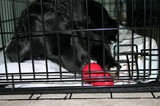
We also decided to give him some *new* dog treats stuffed inside his KONG toy and his favorite pressed rawhide bone only when he was inside the crate from now on.
These “positives” helped to make it a pleasant experience for Destin to be inside his kennel.
#5. Never use the crate as a bargaining tool or as a form of punishment.
A few times, in the course of living with two rambunctious dogs in a small house, I’ve been tempted to “bribe” them — when all else has failed and they are simply not listening to my pleas to chill out and stop whatever it is they’re doing.
But, no matter what, you can never use the crate as a form of punishment… or, as a bargaining chip whenever you’re communicating with your dogs.
“Stop it, or you’re going in the crate!” will set you back a few weeks in the course of your crate-training process. Especially if you carry out your threats and make the dog(s) go in the kennel at a time when they were being “bad”.
It’s simply confusing to the dog.
So remember, time inside the crate should always be a positive experience.
#6. Don’t force your dog inside the kennel.
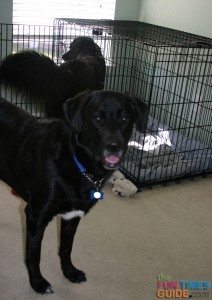 Take it from me, this could mean that you have to adjust your personal schedule (or arrive late sometimes), simply because you haven’t allotted enough time to properly crate the dog, stuff the KONG toy with dog treats, put his favorite toys in the kennel, etc.
Take it from me, this could mean that you have to adjust your personal schedule (or arrive late sometimes), simply because you haven’t allotted enough time to properly crate the dog, stuff the KONG toy with dog treats, put his favorite toys in the kennel, etc.
Your aim is for your dog to have a good experience with each and every aspect of the crate — from entering, to lying down, to standing up, to playing with *new* or “all-time favorite” dog toys, to snacking on his most favorite dog treats, to spending long hours inside the kennel, to the moment the door is opened and he’s eventually let out of the crate.
I am reminded of this:
As with other forms of dog training, you should never set your dog up to fail. Forcing your dog inside the crate only increases his anxiety, and puts him on edge right from the start. This increases the likelihood that he will perform some form of destructive behavior inside the crate. You are setting him up to fail.
Instead, try this:
Set things up so that your dog always views himself as having succeeded. With crate-training… you should go through a series of baby steps where your dog is rewarded for spending even milliseconds inside the crate without barking or digging. This is setting him up to succeed!
Your dog should always enter the kennel of his own free will. That is the first sign of success, and he should be rewarded dearly (with a special treat) for that tiny bit of success.
#7. Praise & reward like crazy whenever you spot even the tiniest bit of progress.
Every time we come home, we go straight to Destin’s crate and let him out — before we let our other dog out of his kennel.
At the same time, we give Destin tons of praise for being good in the crate. (“Good” is a relative term… To us, Destin is “good” if he’s made some improvement over his past behaviors.)
Here’s what we did:
- Every time we saw LESS destruction inside the crate than the time before, we gave him MORE praise than the time before. It started with your basic (unemotional) “Good boy. Good dog in the kennel.” This was immediately followed by a big bear hug, at which point, we would all trot outside for frolicking and fun in the backyard.
- The next time, there was (thankfully) even less destruction, so we raised the pitch of our praise to sound even happier with Destin’s progress, and we physically showed him with longer hugs and bigger smiles that we were very proud of him for being a “good boy inside the kennel.”
- Eventually, the destruction stopped altogether, so we jumped for joy, gave lots of hugs the moment he came out of the crate, and shouted to the hilltops: “Destin is a good boy!… Good dog inside the kennel!”. Lots of hugs. Lots of praise. You want your dog to know — without question — how incredibly proud you are of his achievement and how this FUN time together of hugging and praising will happen every time that he’s good inside the crate.
And that’s where we are today. Destin still gets an over-the-top amount of praise for being “good” for whatever length of time he has just spent inside the crate.
And the destructive behaviors stopped completely after about one week. (Granted, when you’re in the midst of that one week of craziness, it’s not fun. And you feel like you’re torturing your dog. But you’re not. There’s a way to crate train with kindness and patience and a way to crate train with fear and punishment. Kindness and patience always wins.)
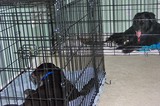 In the end, despite the fact that this process of crate training our adult dog was one heck of a roller-coaster ride — smooth sailing at first, followed by some quite torturous days (and nights), topped off with quiet and peaceful time spent in the kennel (not to mention all the knots that built up in our stomachs from not knowing what we’d find when we returned home!) — we are SO thankful that we stuck with it!
In the end, despite the fact that this process of crate training our adult dog was one heck of a roller-coaster ride — smooth sailing at first, followed by some quite torturous days (and nights), topped off with quiet and peaceful time spent in the kennel (not to mention all the knots that built up in our stomachs from not knowing what we’d find when we returned home!) — we are SO thankful that we stuck with it!
It’s better for both of our dogs (…they each have their own “space” now). It’s better for us (…we feel more “in control” now). And it makes for a happier home overall.




